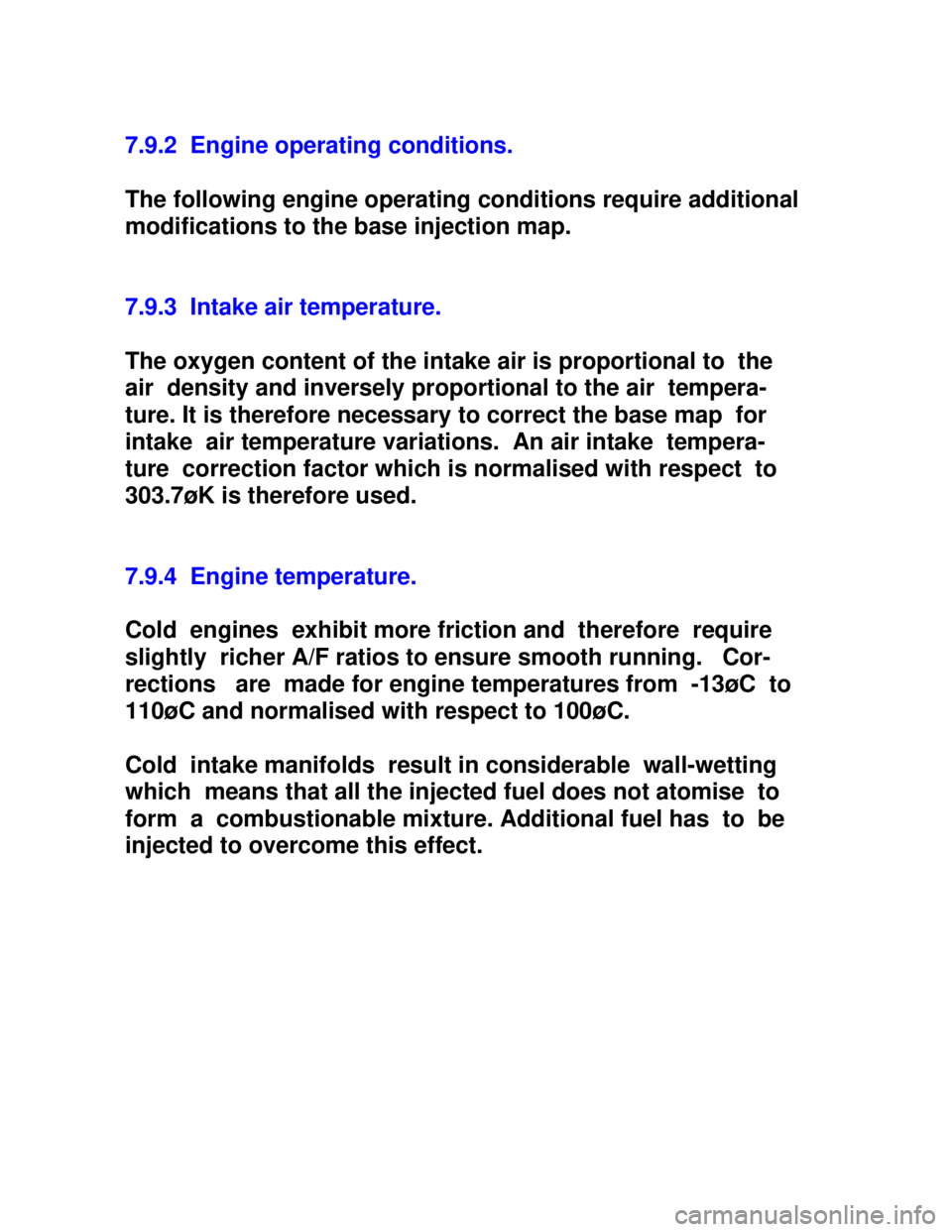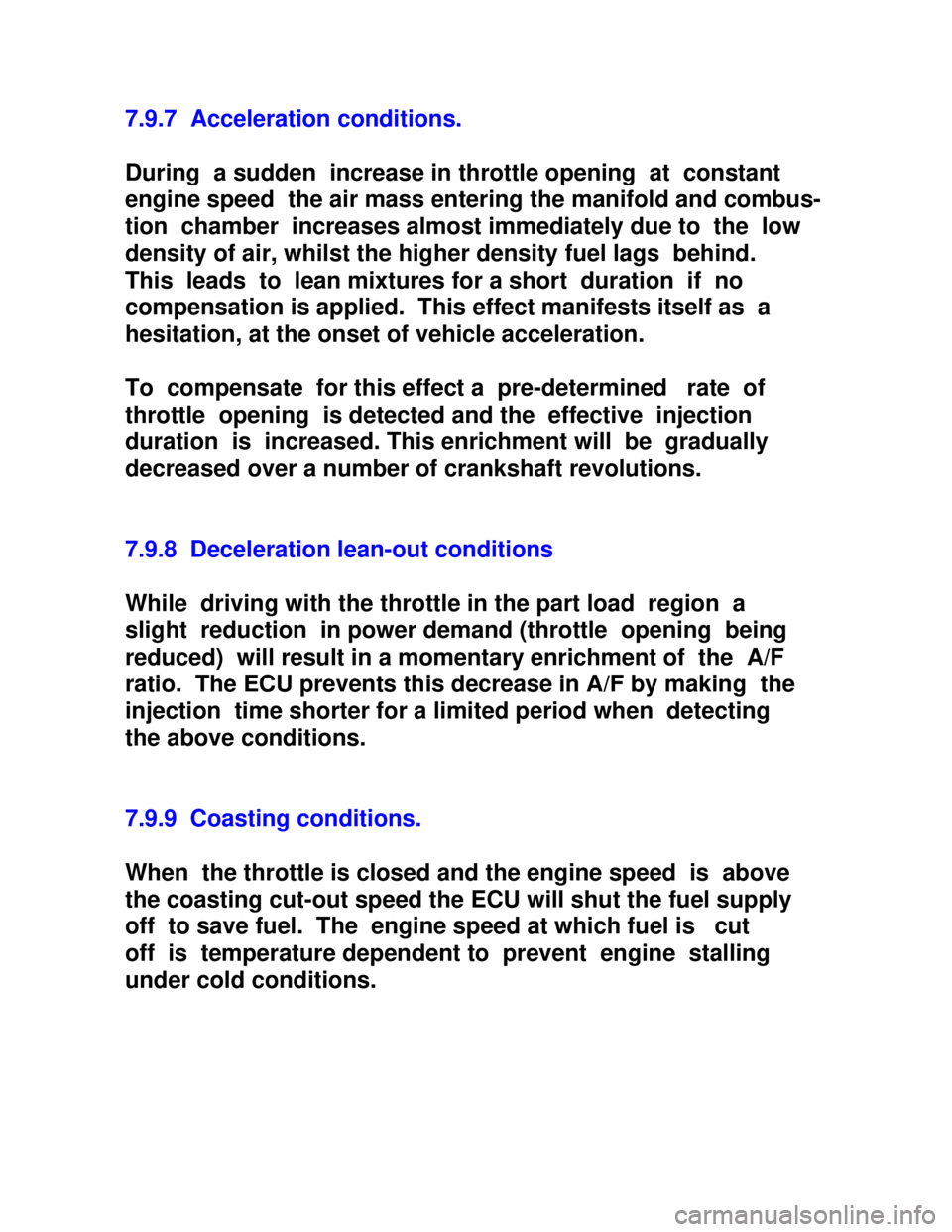Page 1057 of 1070

Downloaded from www.Manualslib.com manuals search engine 7.9.2 Engine operating conditions.
The following engine operating conditions require additional
modifications to the base injection map.
7.9.3 Intake air temperature.
The oxygen content of the intake air is proportional to the
air density and inversely proportional to the air tempera-
ture. It is therefore necessary to correct the base map for
intake air temperature variations. An air intake tempera-
ture correction factor which is normalised with respect to
303.7øK is therefore used.
7.9.4 Engine temperature.
Cold engines exhibit more friction and therefore require
slightly richer A/F ratios to ensure smooth running. Cor-
rections are made for engine temperatures from -13øC to
110øC and normalised with respect to 100øC.
Cold intake manifolds result in considerable wall-wetting
which means that all the injected fuel does not atomise to
form a combustionable mixture. Additional fuel has to be
injected to overcome this effect.
Page 1058 of 1070

Downloaded from www.Manualslib.com manuals search engine 7.9.5 Cold starting conditions.
Definition: Engine speed < 450 r.p.m.
During cold start conditions the low inlet manifold tempera-
tures cause considerable fuel condensation on the inner
walls of the manifold. This condition is known as wall
wetting. To ensure correct A/F ratios it is necessary to
increase the quantity of fuel injected during cold starting
conditions to counteract wall wetting. A correction factor
is applied to the base map for engine temperatures between
-40øC and 100øC.
To prevent the engine from flooding the enrichment factor is
not only engine temperature dependent, but also time depend-
ent. This is implemented by reducing the enrichment factor
over a number of crankshaft revolutions, regardless of
engine temperature. If the ignition is turned off and an
attempt is made to re-start the engine the process is re-
peated.
7.9.6 Post start and warm-up conditions.
Definition: Engine speed > 450 r.p.m.
Engine temperature < 80øC
During these conditions the engine temperature is monitored
and the A/F ratio is decreased by lengthening the base map
injection duration to ensure smooth running of the engine
and to compensate for inlet manifold wall-wetting.
Page 1059 of 1070

Downloaded from www.Manualslib.com manuals search engine 7.9.7 Acceleration conditions.
During a sudden increase in throttle opening at constant
engine speed the air mass entering the manifold and combus-
tion chamber increases almost immediately due to the low
density of air, whilst the higher density fuel lags behind.
This leads to lean mixtures for a short duration if no
compensation is applied. This effect manifests itself as a
hesitation, at the onset of vehicle acceleration.
To compensate for this effect a pre-determined rate of
throttle opening is detected and the effective injection
duration is increased. This enrichment will be gradually
decreased over a number of crankshaft revolutions.
7.9.8 Deceleration lean-out conditions
While driving with the throttle in the part load region a
slight reduction in power demand (throttle opening being
reduced) will result in a momentary enrichment of the A/F
ratio. The ECU prevents this decrease in A/F by making the
injection time shorter for a limited period when detecting
the above conditions.
7.9.9 Coasting conditions.
When the throttle is closed and the engine speed is above
the coasting cut-out speed the ECU will shut the fuel supply
off to save fuel. The engine speed at which fuel is cut
off is temperature dependent to prevent engine stalling
under cold conditions.
Page 1063 of 1070
Downloaded from www.Manualslib.com manuals search engine 10 DEFAULT MODE SELECTION
When the ECU detects a faulty signal from one of its sensors
it will substitute a default signal value to enable the
vehicle to be driven with degraded performance (see para-
graph 10.1).
Faulty sensor Substitute value/sensor
_____________________________________________________
______
EWT Warm engine - 100 øC
MAT 31 øC
Fuel map selector Zero percent enrichment
Timing map selector Map T1 - RON 87D
TPS Idle speed - 1,000 to
2,000 r.p.m.
MAP TPS and idle speed -
1,000 to 2,000 r.p.m.
Disable distributor
bypass operation and
fix spark timing at
10ø BTDC
CO potentiometer Zero percent
Page 1065 of 1070
Downloaded from www.Manualslib.com manuals search engine DIAGNOSTIC CODES
Code Cause
_____________________________________________________
14 Coolant temperature sensor voltage too low
15 Coolant temperature sensor voltage too high
21 TPS voltage too high
22 TPS voltage too low
25 MAT sensor voltage too low
26 MAT sensor voltage too high
33 MAP sensor voltage too high
34 MAP sensor voltage too low
35 Idle control stepper motor failure
36 Timing map selector error
42 Reference signal error/Engine stall
(Diagnostic lamp will not turn ON)
44 Fuel map selector error
48 Battery voltage too low
49 Battery voltage too high
65 CO potentiometer voltage out of range
Page 1068 of 1070
Downloaded from www.Manualslib.com manuals search engine 11.2.8 Timing map selector: The resistance between terminal
19B and 22B measured on the harness connector with the
ECU removed should be:
97 RON - 470 ohm
93 RON - 220 ohm
87 RON - 4,700 ohm
87D RON - 5,600 ohm
11.2.9 Fuel mixture selector: The resistance between terminal
18B and 11A measured on the harness connector with the
ECU removed should be:
-15% - 274 ohm
-10% - 340 ohm
-05% - 412 ohm
+05% - 619 ohm
+10% - 768 ohm
+15% - 931 ohm
+20% - 1180 ohm
+25% - 1500 ohm